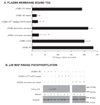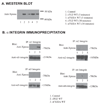Factor XIIIA mobilizes transglutaminase 2 to induce chondrocyte hypertrophic differentiation
- PMID: 18544639
- PMCID: PMC2615675
- DOI: 10.1242/jcs.011262
Factor XIIIA mobilizes transglutaminase 2 to induce chondrocyte hypertrophic differentiation
Abstract
Two transglutaminases (TGs), factor XIIIA (FXIIIA) and TG2, undergo physiologic upregulation in growth plate hypertrophic chondrocytes, and pathological upregulation in osteoarthritic cartilage. Externalization of guanine-nucleotide-bound TG2 drives chondrocyte maturation to hypertrophy, a state linked to matrix remodeling and calcification. Here, we tested the hypothesis that FXIIIA also promotes hypertrophic differentiation. Using human articular chondrocytes, we determined that extracellular FXIIIA induced chondrocyte hypertrophy associated with rapid movement of TG2 to the cell surface. Site-directed mutagenesis revealed that FXIIIA Pro37 bordering the thrombin endoproteolytic Arg38-Gly39 site, but not intrinsic TG catalytic activity, were necessary for FXIIIA to induce chondrocyte hypertrophy. TGs have been demonstrated to interact with certain integrins and, during osteoarthritis (OA), alpha1beta1 integrin is upregulated and associated with hypertrophic chondrocytes. FXIIIA engaged alpha1beta1 integrin in chondrocytes. Antibody crosslinking of alpha1beta1 integrin mobilized TG2. Conversely, an alpha1beta1-integrin-specific blocking antibody inhibited the capacity of FXIIIA to induce TG2 mobilization to the cell surface, phosphorylation of p38 MAP kinase, and chondrocyte hypertrophy. Our results identify a unique functional network between two cartilage TG isoenzymes that accelerates chondrocyte maturation without requirement for TG-catalyzed transamidation by either TG.
Figures







References
-
- AbdAlla S, Lother H, Langer A, el Faramawy Y, Quitterer U. Factor XIIIA transglutaminase crosslinks AT1 receptor dimers of monocytes at the onset of atherosclerosis. Cell. 2004;119:343–354. - PubMed
-
- Aeschlimann D, Mosher D, Paulsson M. Tissue transglutaminase and factor XIII in cartilage and bone remodeling. Semin Thromb Hemost. 1996;22:437–443. - PubMed
-
- Akimov SS, Belkin AM. Cell-surface transglutaminase promotes fibronectin assembly via interaction with the gelatin-binding domain of fibronectin: a role in TGFbeta-dependent matrix deposition. J Cell Sci. 2001;114:2989–3000. - PubMed
Publication types
MeSH terms
Substances
Grants and funding
LinkOut - more resources
Full Text Sources
Other Literature Sources
Molecular Biology Databases
Research Materials
Miscellaneous

